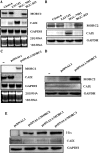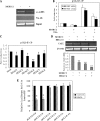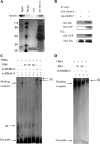Involvement of histone deacetylation in MORC2-mediated down-regulation of carbonic anhydrase IX
- PMID: 20110259
- PMCID: PMC2875037
- DOI: 10.1093/nar/gkq006
Involvement of histone deacetylation in MORC2-mediated down-regulation of carbonic anhydrase IX
Abstract
Carbonic anhydrase IX (CAIX) plays an important role in the growth and survival of tumor cells. MORC2 is a member of the MORC protein family. The MORC proteins contain a CW-type zinc finger domain and are predicted to have the function of regulating transcription, but no MORC2 target genes have been identified. Here we performed a DNA microarray hybridization and found CAIX mRNA to be down-regulated 8-fold when MORC2 was overexpressed. This result was further confirmed by northern and western blot analysis. Our results also showed that the protected region 4 (PR4) was important for the repression function of MORC2. Moreover, MORC2 decreased the acetylation level of histone H3 at the CAIX promoter. Meanwhile, trichostatin A (TSA) had an increasing effect on CAIX promoter activity. Among the six HDACs tested, histone deacetylase 4 (HDAC4) had a much more prominent effect on CAIX repression. ChIP and ChIP Re-IP assays showed that MORC2 and HDAC4 were assembled on the same region of the CAIX promoter. Importantly, we further confirmed that both proteins are simultaneously present in the PR4-binding complex. These results may contribute to understanding the molecular mechanisms of CAIX regulation.
Figures








Similar articles
-
DNA damage is a prerequisite for p53-mediated proteasomal degradation of HIF-1alpha in hypoxic cells and downregulation of the hypoxia marker carbonic anhydrase IX.Mol Cell Biol. 2004 Jul;24(13):5757-66. doi: 10.1128/MCB.24.13.5757-5766.2004. Mol Cell Biol. 2004. PMID: 15199132 Free PMC article.
-
Optimization of a novel peptide ligand targeting human carbonic anhydrase IX.PLoS One. 2012;7(5):e38279. doi: 10.1371/journal.pone.0038279. Epub 2012 May 31. PLoS One. 2012. PMID: 22693612 Free PMC article.
-
Lowered oxygen tension induces expression of the hypoxia marker MN/carbonic anhydrase IX in the absence of hypoxia-inducible factor 1 alpha stabilization: a role for phosphatidylinositol 3'-kinase.Cancer Res. 2002 Aug 1;62(15):4469-77. Cancer Res. 2002. PMID: 12154057
-
Carbonic anhydrase IX (CAIX) as a mediator of hypoxia-induced stress response in cancer cells.Subcell Biochem. 2014;75:255-69. doi: 10.1007/978-94-007-7359-2_13. Subcell Biochem. 2014. PMID: 24146383 Review.
-
[Carbonic anhydrase IX-based tumor imaging and therapy: a review].Sheng Wu Gong Cheng Xue Bao. 2023 Jan 25;39(1):116-131. doi: 10.13345/j.cjb.220470. Sheng Wu Gong Cheng Xue Bao. 2023. PMID: 36738205 Review. Chinese.
Cited by
-
MORC2 regulates RBM39-mediated CDK5RAP2 alternative splicing to promote EMT and metastasis in colon cancer.Cell Death Dis. 2024 Jul 24;15(7):530. doi: 10.1038/s41419-024-06908-y. Cell Death Dis. 2024. PMID: 39048555 Free PMC article.
-
Potential for New Therapeutic Approaches by Targeting Lactate and pH Mediated Epigenetic Dysregulation in Major Mental Diseases.Biomedicines. 2024 Feb 18;12(2):457. doi: 10.3390/biomedicines12020457. Biomedicines. 2024. PMID: 38398057 Free PMC article. Review.
-
Neuropathic MORC2 mutations perturb GHKL ATPase dimerization dynamics and epigenetic silencing by multiple structural mechanisms.Nat Commun. 2018 Feb 13;9(1):651. doi: 10.1038/s41467-018-03045-x. Nat Commun. 2018. PMID: 29440755 Free PMC article.
-
Microrchidia CW-Type Zinc Finger 2, a Chromatin Modifier in a Spectrum of Peripheral Neuropathies.Front Cell Neurosci. 2022 Jun 3;16:896854. doi: 10.3389/fncel.2022.896854. eCollection 2022. Front Cell Neurosci. 2022. PMID: 35722617 Free PMC article. Review.
-
Innate responses to gene knockouts impact overlapping gene networks and vary with respect to resistance to viral infection.Proc Natl Acad Sci U S A. 2018 Apr 3;115(14):E3230-E3237. doi: 10.1073/pnas.1720464115. Epub 2018 Mar 20. Proc Natl Acad Sci U S A. 2018. PMID: 29559532 Free PMC article.
References
-
- Robertson N, Potter C, Harris AL. Role of carbonic anhydrase IX in human tumor cell growth, survival and invasion. Cancer Res. 2004;64:6160–6165. - PubMed
-
- Potter C, Harris AL. Hypoxia inducible carbonic anhydrase IX, marker of tumor hypoxia, survival pathway and therapy target. Cell Cycle. 2004;3:164–167. - PubMed
-
- Gut MO, Parkkila S, Vernerová Z, Rohde E, Závada J, Höcker M, Pastorek J, Karttunen T, Gibadulinová A, Závadová Z, et al. Gastric hyperplasia in mice with targeted disruption of the carbonic anhydrase gene Car9. Gastroenterology. 2002;123:1889–1903. - PubMed
-
- Driessen A, Landuyt W, Pastorekova S, Moons J, Goethals L, Haustermans K, Nafteux P, Penninckx F, Geboes K, Lerut T, et al. Expression of Carbonic Anhydrase IX (CA IX), a hypoxia-related protein, rather than Vascular-Endothelial Growth Factor (VEGF), a pro-angiogenic factor, correlates with an extremely poor prognosis in esophageal and gastric adenocarcinomas. Ann. Surg. 2006;243:334–340. - PMC - PubMed
-
- Airley RE, Loncaster J, Raleigh JA, Harris AL, Davidson SE, Hunter RD, West CM, Stratford IJ. GLUT-1 and CAIX as intrinsic markers of hypoxia in carcinoma of the cervix: relationship to pimonidazole binding. Int. J. Cancer. 2003;104:85–91. - PubMed
Publication types
MeSH terms
Substances
LinkOut - more resources
Full Text Sources
Molecular Biology Databases
Research Materials

